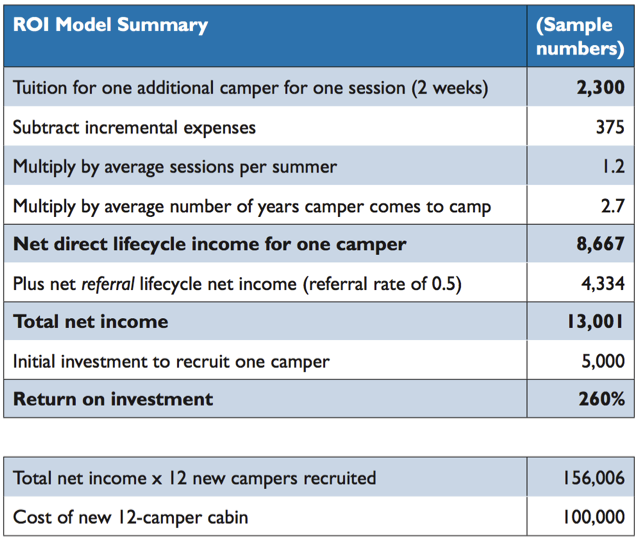
Here are four things your friends with MBAs know. In ten minutes, you’ll know what they know, and how to begin applying it to your camp.
“Marginal costs” versus “average costs”
One camp director recently told me, “My first camper costs me two million bucks. My 250th camper costs me a hundred bucks.” By the time you enroll your last camper for the season, additional expenses required to host that camper are minimal. These additional, incremental costs are known as marginal costs to economists and people with MBAs. By contrast, your average cost per camper calculation (total costs divided by total enrollment) is a much higher number, and it is important to increasingly ignore this statistic as the summer approaches and you’re considering substantial discounts to capacity enrollment. Remember the potential lifetime value of that additional camper vs. the relatively small marginal cost to host them this year.
Segmenting your market
You want to charge full freight to the families who can afford it. For other families, you want to lower the price just enough to make it possible for them to attend - perhaps all the way down until you’re losing money. But regardless of ability to pay, families are going to look for the lowest price. The different devices to reveal only the discounts that are necessary to bring the price down to a given family’s precise ability and willingness to pay (i.e., no more, and no less) is called segmenting your market. High performing camps have formal, multi-tiered, and simultaneous strategies to market to and track their families in order to maximize revenue and enrollment.
ROI
It stands for Return on Investment! Here’s how it works in a camp environment.
- Calculate your net income for enrolling one camper for one session: Subtract incremental expenses from tuition for one camper for one session.
- Multiply that number by: average sessions per summer, average years of attendance, and average number of referrals that come from an individual camper (family).
- Then to calculate ROI, simply compare that number to your estimated costs for recruiting that single camper.

These numbers can be tricky to come by, but once you do, we find that camps tend to be shocked and inspired by what a modest but targeted investment in enrollment can yield. Need help? We have a
detailed tool to help you calculate ROI.
Competitive Analysis
You probably know a lot about what your peers are doing, but without a regular and systematic analysis, you can easily be missing some key insights. Or at the very least, a competitive analysis can provide the data to affirm and back up your intuition, helping you make a case for changes or spending increases. To figure out who your competitors are, consider: movement, size, geography, and program/theme. Your analysis should compare price levels and incentives, marketing and messaging, session structure and calendar, and staffing credentials (to the extent possible). Sometimes this research uses the “secret shopper” strategy.
Congratulations!
Unfortunately, no, we can't award you an MBA. But you can use these lessons to make your camp more successful. Good luck!
**
Written by Aron Goldman. Aron is a Mentor with JCamp 180. Aron’s focus areas at JCamp 180 include camper enrollment, recruitment, and retention. He also directs our year-long Enrollment Program. Aron also has experience working as a consultant with grassroots, regional, national, and international organizations in the areas of capacity-building, strategy, and systemic change.
**
Who we are: JCamp 180 is a program of the Harold Grinspoon Foundation (HGF). Our goal is to significantly enhance the long-term effectiveness of nonprofit Jewish camps in North America. To meet this goal, we provide affiliated Jewish camps with consulting services, annual conferences, shared resources, professional development, and matching grant opportunities. Find more at www.jcamp180.org